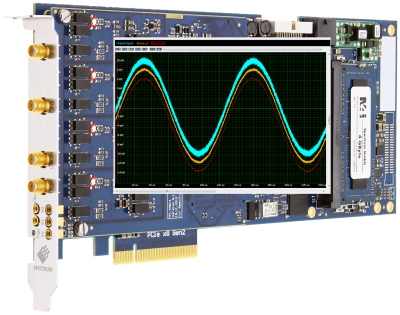 |
 |

Main Menu
Newsletter
News Area
Info Area
Weblinks
Product Focus

Readers Top 5 News of last 30 days
- 27 March 2024 - GPP 5G Conformance Test Solutions with small Footprint
- 25 March 2024 - Debug and Trace Support for new Arm Automotive CPUs
- 03 April 2024 - 5-in-1 Programmable Oscilloscopes
- 05 April 2024 - Oscilloscope Days event in April 2024
- 26 March 2024 - AWG generates up to 20 independent Sine Waves
News - General T&M
Boxcar Function smooths out Noise to give clear Signals
 24 May 2017 - Spectrum GmbH announced a new function for its extensive range of modularly designed digitizers. The Boxcar averaging function smooths out high frequency noise to give a clear signal. It is most useful in situations where signals have been oversampled and it can be used to increase vertical resolution, lower noise and improve dynamic characteristics such as signal-to-noise ratio (SNR) and spurious free dynamic range (SFDR). It uses a mathematical signal processing function to effectively recalculate the vertical value of each acquired data point by averaging it with adjacent sample points.
24 May 2017 - Spectrum GmbH announced a new function for its extensive range of modularly designed digitizers. The Boxcar averaging function smooths out high frequency noise to give a clear signal. It is most useful in situations where signals have been oversampled and it can be used to increase vertical resolution, lower noise and improve dynamic characteristics such as signal-to-noise ratio (SNR) and spurious free dynamic range (SFDR). It uses a mathematical signal processing function to effectively recalculate the vertical value of each acquired data point by averaging it with adjacent sample points.
To allow maximum flexibility, the Boxcar function allows users to select the number of adjacent points to be averaged from 2 to 256. The averaged data is subsequently stored with higher resolution by an amount that is proportional to the number of points selected. For example, selecting two adjacent points would increase the resolution of a 16 Bit digitizer to that equivalent to 17 Bits, selecting four adjacent points equates to 18 Bits and selecting the maximum 256 points would produce a theoretical 24 Bits.
“Boxcar averaging is an excellent tool for improving the measurement performance of high-speed high-resolution digitizers,” said Spectrum’s Director of Technology, Oliver Rovini. “By taking advantage of situations where signals have been oversampled, the function delivers a number of clear benefits. Not only does Boxcar averaging reduce the effect of high frequency noise but it also improves results in low noise level situations. For example, on high purity signals our own tests have shown that a digitizer’s performance, as measured by its effective number of bits (ENOB), can be improved by at least 2 Bits when using Boxcar averaging. SFDR and SNR measurements are also better by more than 12 dB.”
The downside of Boxcar averaging is that the averaged waveforms are effectively filtered so that some high-frequency signal content may be lost. However, if the signals of interest are at frequencies well below the sampling rate of the digitizer, then the technique offers a number of advantages. For example, unlike traditional averaging methods, Boxcar averaging works for single shot acquisitions without the need for multiple trigger events or a repeatable signal. Boxcar averaged waveforms are also decimated (by the averaging factor) so that stored waveforms are reduced in size and can be transferred and processed faster. Even though the resulting waveforms are decimated, the Spectrum implementation makes sure that the trigger detection is still running with full sampling speed so that there is always a very precise timing relationship between the averaged signal and the trigger position.
The Boxcar averaging mode is fully programmable with Spectrum’s standard drivers that support all of the most common programming languages. For those users not wanting to write their own programs, Spectrum offers SBench 6-Pro, an easy-to-use, graphical user interface. SBench 6 provides control of all the digitizer’s operating modes and settings. It displays, stores and processes waveforms and can even be used to document results.
http://spectrum-instrumentation.com/
Related Articles:

Upcoming Events
More events...
See our Trade Show Calendar
Click here
Tag Cloud
© All about Test 2018
 How to resolve AdBlock issue?
How to resolve AdBlock issue?